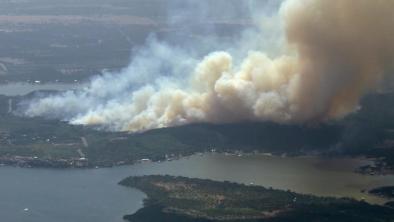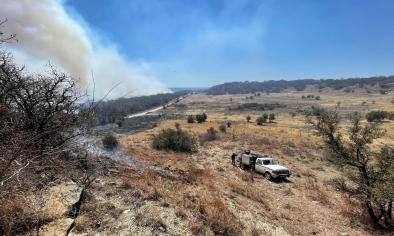Texas Wildfire Season 2022
Human-caused climate change impacts such as extended periods of drought conditions and warm temperatures have caused the wildfire season in Texas to become an increasing threat to life and property. In early 2022, persistent drought conditions increased the risk of an active wildfire season. By mid-March, several fires merged to form the Eastland Complex fire, which burned more than 54,000 acres, becoming Texas' largest wildfire to date. The Eastern Complex fires resulted in $23.1 million in preliminary agricultural loss estimates, according to Texas A&M AgriLife Extension Service economists.

Climate science at a glance
- Climate change has increased wildfire risk in much of the U.S. by increasing the frequency of hot, dry, and windy weather.
- Areas in Texas commonly affected by wildfires are likely expanding eastward as fuels become drier faster in a warmer climate.
- Wildfire risk in the southern Great Plains will increase throughout the region as temperatures rise, particularly in the summer, and the duration of the fire season increases.
Background
When is the Texas wildfire season?
The term ‘fire season’ is a period of time when, due to climate and weather patterns, wildfires are likely to occur, spread, and affect resource values sufficient to warrant organized fire management activities.
Brad Smith is a meteorologist with the Texas A&M Forest Service says unlike other areas of the country, Texas has wildfire seasons almost year-round. “We can be in a fire season any time that we see three to four weeks of extended drying” said Smith.
What factors influence wildfire risk?
Wildfires are affected by a number of weather and climate factors including temperature, winds, humidity, surface dryness, and the amount of vegetation available to burn (known as fuel load). Click to see a map of Texas' daily wildfire risk and forecast risk. Other helpful links can be found at Texas' Parks and Wildlife wildland forest management page.
Climate signals breakdown
Climate signals #1, #2, & #3: Wildfire Risk Increase & Drought Risk & Land Surface Temperature Increase
In semi-arid environments - including the Southwest and large portions of the Great Plains - hotter temperatures can dry out land. Climate change made the 2011 Texas drought more likely to occur; specifically, it greatly increased the frequency of hot temperatures by an order of magnitude and likely decreased precipitation totals. Climate change has made extreme precipitation deficits (like those in the Central US in summer 2012) three to four times more likely.
In 2020, the Texas State Climatologist’s Office released a report on current and future trends related to extreme weather in Texas. The report says that the eastern area of Texas, in particular, will be prone to more drought and wildfire, and the change could come on quickly as the climate gets drier from west to east.
“We’re definitely going to have hotter droughts when they occur, which means things dry out faster and that by itself increases the risk of wildfire."
John Nielson-Gammon, Texas state climatologist
Observations consistent with climate signal #1, #2 & #3
- In mid-March, the Eastland Complex fire - comprised of the Kidd, Blowing Basin, Wheat Field, Cedar Mountain, Mangum, Oak Mott and Walling fires - has burned more than 54,000 acres, surpassing the size of the 2011 Bastrop County Complex fire, which burned more than 34,000 acres, becoming Texas' largest wildfire to date. The largest single blaze in the Eastland Complex is the Kidd fire, which has burned at least 42,000 acres and was only 40 percent contained as of March 21.
- Statewide average temperature from December through February was 2.9°F above the 20th century average.
- By mid-March, parts of Texas were in the midst of Severe Drought conditions.
- Drought conditions in 2022 are on pace with the record drought year of 2011. In mid-March 2011, 97% of the state was experiencing abnormally dry conditions, compared to 96% in 2022. As in 2011, drought is expected to expand in the coming months amid warmer conditions.
Climate signal #4: Season Creep
As temperatures continue to increase, spring is arriving much sooner, while winters are becoming shorter and milder. Changes in the timing of the seasons have been documented around the world — through studies on plant and animal development and life cycles, temperature and snow cover — and informally dubbed “season creep.” This can lead to the expansion of wildfire seasons into cooler months.
Observations consistent with climate signal #4
- The number of fires in 2022 has been higher than average, especially for this time of year.
- Recent temperatures have increased in all seasons and in all regions of Texas.







